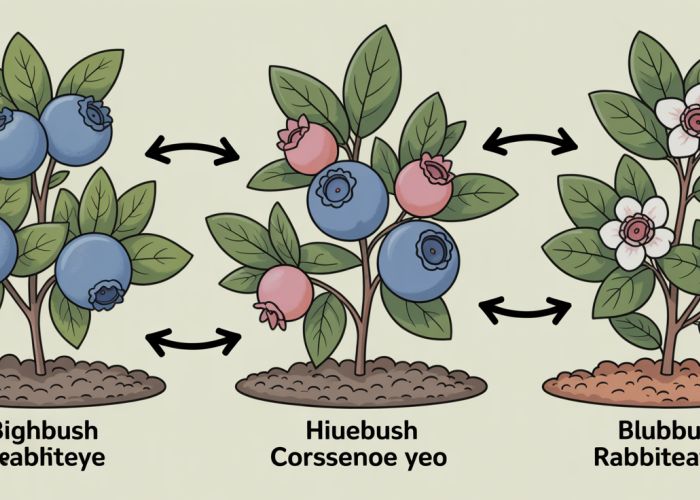Successful blueberry cultivation depends significantly on understanding blueberry cross pollination compatibility, a factor impacting fruit set and yield. Highbush blueberries, for example, often benefit from cross-pollination with different varieties to maximize fruit production. Research from institutions like the University of Florida’s IFAS Extension emphasizes the importance of selecting compatible cultivars for optimal blueberry cross pollination compatibility. The chilling requirement for various blueberry types influences cultivar selection to ensure synchronized blooming, further enhancing successful cross-pollination outcomes.

Optimizing Your "Unlock Bumper Crops: Blueberry Cross-Pollination Guide" Article Layout
A well-structured article about blueberry cross-pollination is crucial for helping gardeners understand how to maximize their yields. Focusing on "blueberry cross pollination compatibility" as the main keyword, the article should be laid out logically to guide the reader through the process. Here’s a suggested structure:
Introduction: The Importance of Cross-Pollination
- Start by highlighting the benefits of cross-pollination in blueberries.
- Explain that most blueberry varieties are not self-pollinating or produce significantly better yields with cross-pollination.
- Briefly mention the increased fruit size, higher berry counts, and earlier ripening that can result.
- Clearly state the article’s objective: to help readers understand which blueberry varieties are compatible for cross-pollination and how to achieve optimal pollination.
- Introduce the keyword "blueberry cross pollination compatibility" naturally. For instance: "Understanding blueberry cross pollination compatibility is key to achieving those abundant harvests."
Understanding Blueberry Varieties
-
This section provides the necessary context for understanding the compatibility charts.
Blueberry Species Overview
- Briefly describe the main types of blueberries commonly grown (e.g., Northern Highbush, Southern Highbush, Rabbiteye, Half-High).
- Emphasize that compatibility is often higher within species than between species.
Chill Hour Requirements
- Explain the concept of chill hours and why it’s important for choosing compatible varieties.
- Stress the need to select varieties with similar chill hour requirements for successful pollination and fruit set.
- Provide a general guideline for chill hour ranges for each blueberry type.
Blueberry Cross Pollination Compatibility Explained
-
This is the core of the article and should directly address the main keyword.
Factors Affecting Compatibility
- Genetic Proximity: Explain that varieties that are closely related genetically are more likely to be compatible.
- Bloom Time: Highlight the absolute necessity of overlapping bloom times for successful cross-pollination. A detailed chart in the next section is critical.
- Pollinators: Briefly mention the role of bees and other pollinators in transferring pollen between compatible varieties.
- Environmental Factors: Acknowledge that environmental conditions can impact pollination success.
Compatibility Charts and Lists
-
Present the compatibility information in a clear and easily digestible format. A table format is ideal. Here’s an example of the table structure:
Blueberry Variety Species Chill Hours Bloom Time Compatible Varieties Notes ‘Bluecrop’ Northern Highbush 800-1000 Mid-Season ‘Jersey’, ‘Duke’, ‘Elliott’ Excellent choice for cross-pollination; widely adaptable. ‘Jersey’ Northern Highbush 800-1000 Late-Season ‘Bluecrop’, ‘Elliott’ Old, reliable variety; good for extending the harvest season. ‘O’Neal’ Southern Highbush 200-300 Early-Season ‘Star’, ‘Jewel’ Requires acidic soil; susceptible to cold damage. ‘Tifblue’ Rabbiteye 450-550 Late-Season ‘Brightwell’, ‘Powderblue’ Requires two or more Rabbiteye varieties for optimal pollination. ‘Northblue’ Half-High 800-1000 Early-Season ‘Northland’, ‘Patriot’ More cold hardy than Highbush; good choice for colder climates. -
Provide separate charts for each major blueberry species, if possible, for clarity.
-
Include a "Notes" column for any specific considerations (e.g., soil pH requirements, disease susceptibility).
Optimizing Pollination in Your Blueberry Patch
-
This section focuses on practical tips for maximizing pollination success.
Variety Selection and Placement
- Recommend planting at least two compatible blueberry varieties.
- Suggest planting varieties in close proximity to encourage cross-pollination.
Attracting Pollinators
- Discuss ways to attract bees and other pollinators to the garden (e.g., planting pollinator-friendly flowers, avoiding pesticide use).
- Consider renting a bee hive if necessary.
Monitoring Bloom Times
- Emphasize the importance of observing bloom times in the spring to ensure overlap.
- Suggest keeping records of bloom times for future planning.
Soil and Nutrition
- Remind readers that proper soil pH and nutrition are essential for healthy plants and successful pollination.
- Recommend soil testing and amending the soil as needed.
Troubleshooting Pollination Problems
-
Address potential issues that may hinder successful cross-pollination.
Lack of Pollinators
- Suggest solutions like hand-pollination or attracting more pollinators.
Frost Damage
- Explain how frost can damage blossoms and reduce fruit set.
- Recommend protecting plants from frost during critical bloom times.
Disease and Pests
- Highlight the importance of controlling diseases and pests that can weaken plants and reduce pollination success.
- Recommend specific disease and pest management strategies.
Improper pH
- Remind gardeners that blueberries need acidic soil, and improper pH can significantly affect plant health and ability to produce.
- Advise soil testing and amendment if needed.
Blueberry Cross-Pollination FAQ
Here are some frequently asked questions to help you understand blueberry cross-pollination and how it can improve your harvest.
Why is cross-pollination important for blueberries?
Many blueberry varieties produce significantly larger and more abundant crops when cross-pollinated with a different compatible variety. Cross-pollination improves fruit set and berry size, leading to a better yield.
What does "compatible" mean in blueberry cross pollination compatibility?
Compatible varieties bloom at roughly the same time and are genetically suited to pollinate each other. Not all blueberry varieties are compatible; some pairings will result in little to no benefit.
How do I ensure proper cross-pollination for my blueberries?
Plant two or more different, compatible blueberry varieties close together (within 50-100 feet). This allows bees and other pollinators to easily transfer pollen between the plants.
Where can I find information about blueberry cross pollination compatibility for specific varieties?
Your local nursery or agricultural extension office are great resources for determining which blueberry varieties are compatible in your region. Online resources and blueberry grower guides also often provide compatibility charts.
So, there you have it! Armed with the knowledge of blueberry cross pollination compatibility, get out there and start growing some seriously amazing blueberries. Happy planting!



